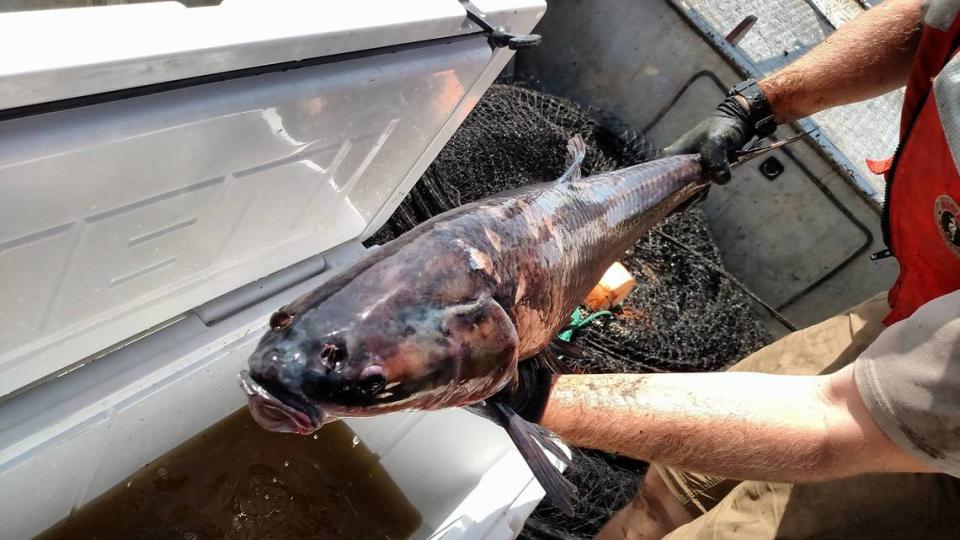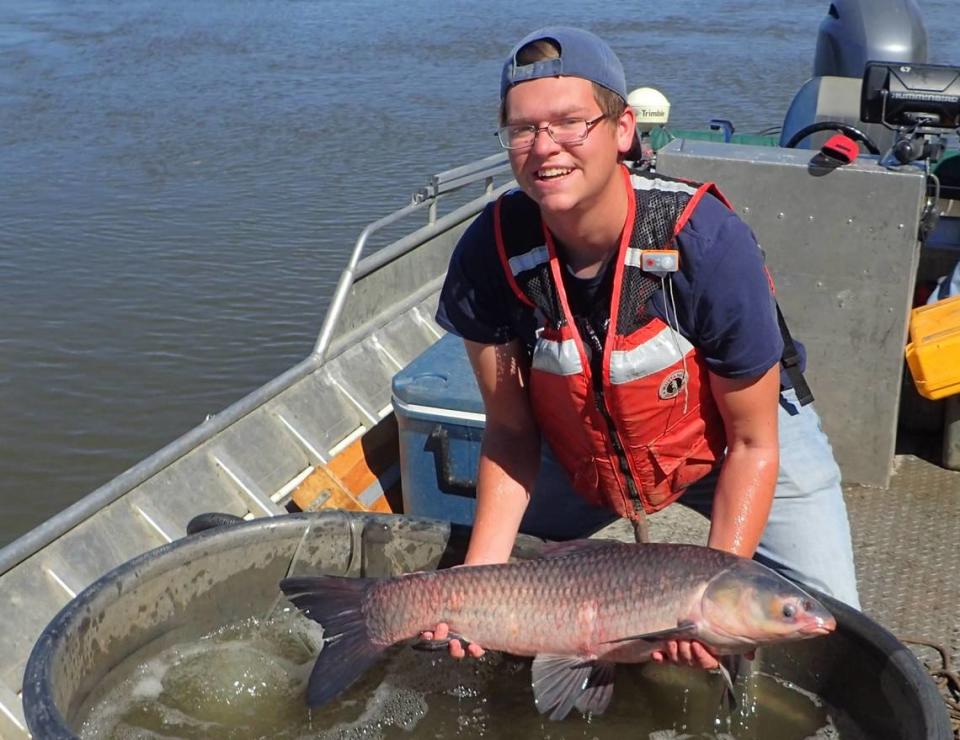This invasive fish threatens KY’s freshwater mussels. Reel in a reward by catching one
In the early 1900s, closer to a time when Kentucky was an unspoiled Eden, jewel-like freshwater mussels paved the beds of the streams and rivers that ran freely throughout the state.
So prized were these mollusk shells, a lucrative clamming industry sprang up along the Mississippi River and its tributaries. From smelly camps on its banks, clammers fished out the creatures in hopes of uncovering a rare pearl.
Most of the time, however, the mussel shells were forged into buttons and often shipped overseas to the sartorial shops of Europe. At its peak, in 1916, the industry employed some 20,000 people in good-paying jobs and produced 40 million mussel-shell buttons thanks to the innovations of automation at the time, according to the Freshwater Mollusk Conservation Society.
But the boom couldn’t last forever. Efforts were made by the U.S. Bureau of Fisheries to artificially propagate the critters, though never to corral the extreme overfishing by roving clammers who harvested freely.
By 1930 and the beginning of the Great Depression, the industry was on the brink of collapse. The Bureau of Fisheries urged the industry to take what it could before “the mussel fishery on the Mississippi River is doomed to economic exhaustion.”
A century later, Kentucky’s freshwater mussel species remain under threat.
Of the 103 mussel species native to Kentucky, 20 have completely vanished from the state. Another 36 are considered rare or endangered, and 46 are on the Kentucky Department of Fish and Wildlife Resources’ list of Species of Greatest Conservation Need.
Freshwater mussels play a critical role in the health of river and stream ecosystems, purifying their waters of silt and algae as it passes over them. Biologists use them as an indicator species; if you find a lot of good mussels in a stream or riverbed, you know it’s healthy, says fish biologist Matthew Dollenbacher with Kentucky Fish and Wildlife.
Today, freshwater mussels are under threat mainly from habitat destruction and pollution, but also by invasive species. In Kentucky and other states, that includes the black carp.
These opportunistic feeders from eastern Asia were first introduced in the U.S. in the 1970s via privately owned aquaculture ponds to control snails. However, they’ve since made a jailbreak.
Black carp can now be found in the hundreds throughout the Mississippi River basin, though fortunately, only a few have been discovered in Western Kentucky, according to Dollenbacher. Large populations of invasive carp, though not black carp, have been found in Kentucky and Barkley lakes in Western Kentucky. They are also found in most backwater lakes in the region associated with the Ohio and Mississippi Rivers, according to Kentucky Fish and Wildlife.
It’s relatively rare for private fishers to catch one, but you may be able to get a bounty if you happen to reel one in. Here’s what to know about the black carp, including tips for identifying them and why they’re a problem for native mussels.
How to distinguish between a black and grass carp
Black carp and grass carp can look very similar, and both are invasive species in North America. There isn’t one easy way to distinguish them based on physical characteristics, but according to the Invasive Carp Regional Coordinating Committee, there are several subtle differences you can spot.
Adult black carp have narrower heads. Compared to a black carp, a grass carp will have a rounder, more torpedo-like head. Black carp, conversely, have a sharper, narrower head much like an arrowhead.
The grass carp has a fuller upper lip. When looking at a grass carp from above while its mouth is closed, you should be able to see its upper lip, which protrudes more than a black carp’s. However, young black carp may also have a protruding upper lip. So this tip is only helpful for identifying adults.

Look at the carp’s lateral line or back shape. A black carp’s lateral line or general silhouette will appear straighter, while the grass carp’s back has more of a curve.
A black carp’s coloration has been described as black, blue gray or dark brown. The fins are particularly pigmented, and the black carp generally has longer pectoral fins than the grass carp. On the other hand, the grass carp often presents an olive color with dusky fins. Still, color is not always a reliable indicator.

Why is the black carp a problem in the Mississippi River basin?
There are four non-native carp species in Kentucky, and all can disrupt native ecosystems.
What can make the black carp a particular problem, however, is it’s the only one of the four that eats mussels and snails and it can grow to more than 100 pounds in size.
According to Dollenbacher, the fish biologist, black carp are also capable of moving into brackish waters, where fresh river water meets the salty water of the ocean.
Black carp crack open hard-shelled mollusks with their molar-like teeth, and they don’t seem to be very picky about what they eat.
From an ecological standpoint, black carp have the potential to radically disrupt benthic zones of waterways by preying on algae-eating mollusks. If algae is allowed to grow unchecked, it can deplete oxygen levels in the water, further stressing these underwater ecosystems.
Black carp can grow to be 5 feet long, weigh upwards of 150 pounds and live as long as 15 years.
That size comes with an enormous appetite, and because of this black carp can snap up food that would have gone to native turtles, other fish, birds (including waterfowl) and mammals such as raccoons, otters and muskrats.
They are also known to transmit diseases and parasites to native species. All of this adds additional strain to the ecosystem.
A bounty to catch black carp
Depending on where you caught your black carp, you may be eligible for reimbursement. Starting in 2021, black carp caught in watersheds upstream of Cairo, Ill., including all of Illinois’ waters and the Missouri, Ohio, Tennessee, Cumberland and Mississippi rivers, may qualify.
Reimbursements are limited to 10 awards per person, per month, however. A handout from the Invasive Carp Regional Coordinating Committee says rewards are subject to funding availability.
If you do happen to catch a black carp, the U.S. Geological Survey and several other government agencies recommend following what they call the “Keep, Cool, Call,” approach.
Those who are sure they’ve caught a black carp should be sure not to throw it back into the river or creek they’ve caught it from. Instead, get some paper and write down as much information as you can.
Fishers should make a note of where they caught the fish (preferably with the exact coordinates) and take some photos of its head and mouth, along with a measurement of its length. Also, make a note of what kind of fishing gear and bait you used, and if possible, other details like substrate type, depth, water temperature and flow.
Fishers are next advised to “humanely kill” the fish and keep it cool on ice. Keeping a live black carp is illegal, and you should not freeze it unless necessary, according to a handout from the Invasive Carp Regional Coordinating Committee.
Finally, you call. For Kentucky, that means calling the state’s fish and wildlife resources agency at 270-226-4192. You can also email your report to Jessica Morris at jessica.morris@ky.gov.
Do you have a question about wildlife in Kentucky for our service journalism team? We’d like to hear from you. Fill out our Know Your Kentucky form or email ask@herald-leader.com.

